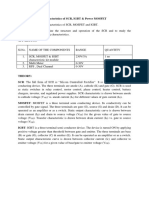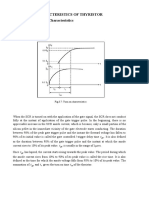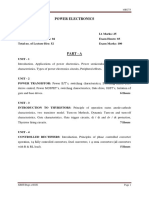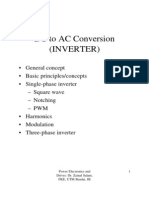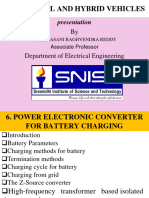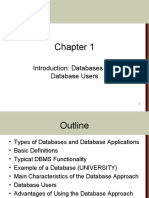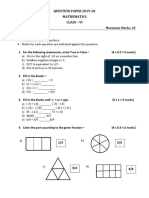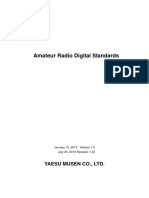PWM Rectifier Design Lab Report
Uploaded by
Sarika ChauhanPWM Rectifier Design Lab Report
Uploaded by
Sarika ChauhanEE-3202: Power
Electronics design Lab
Topic: Design of PWM Rectifier
Submitted BY-
Vikas Kumar Pandey(07000428)
Sarika Chauhan(07000427)
Vaibhav Sharma(07000428)
Abdul Lathief (07000430)
Rahul Reddy (07000431)
Mohit Kumar Gupta (07000432)
2 | P a g e
INDEX
S.No. Topic Page No.
1. Introduction 3
2. PWM rectifier- Operation 4
3. Phasor Diagram 5
4. Control loop Diagram 6
5. Circuit Analysis 7
6. Calculations 9
7. Calculated Results 10
8. Comparison of calculated and simulated
results
10
9. Simulated Circuit and different output
curves.
11
10. Conclusion and its further application 17
11. References 18
3 | P a g e
INTRODUCTION
The electric energy conversion made by semiconducting converters is being used more and
more. This had led to the growth of negative phenomenon that appeared negligible, when
only a few converters are being used. However, the development of semiconductor
structures has enabled higher power to be transmitted and has also led to wide spread of
converters. In this way; converters have a negative effect on the supply network.
The regressive effects of overloads with harmonics and reactive power consumption are
becoming major disadvantages of phase controlled (mostly thyristor) rectifiers. These side
effects need to be compensated by additional filtering circuits with capacitors or
inductances. However, such circuits raise the costs and also increase material and space
requirements for the converter. Phase control and commutation of semiconducting devices
impact the phase displacement between the first harmonics of the consumed current and
the first harmonics of the supply voltage. This displacement leads to power factor
degradation and to reactive power consumption. The consumed current harmonics cause
non-sinusoidal voltage drops on the supply network impedances and lead to supply voltage
deformation. This may cause malfunctions of other devices that are sensible to the
sinusoidal shape of the supply voltage (e.g. measurement apparatuses, communication and
control systems).
The reactive power rises with longer control angle delays, so the rectifier acts as a time
variable impedance that is nonlinear and causes deformed current consumption.
In order to suppress these negative phenomena caused by the power rectifiers, use is made
of rectifiers with a more sophisticated control algorithm. Such rectifiers are realized by
semiconductors that can be switched off i.e. IGBT transistors. The rectifier is controlled by
pulse width modulation. A rectifier controlled in this way consumes current of required
shape, which is mostly sinusoidal. It works with a given phase displacement between the
consumed current and the supply voltage. The power factor can also be controlled and
there are minimal effects on the supply network.
The function of the rectifier depends on the supply type of network. There are two types of
supply network hard and soft. Ordinary rectifiers, which work on a relatively hard
supply network, do not affect the shape of the supply voltage waveform. Harmonics
produce electromagnetic distortion, and the network will be loaded with reactive power.
The PWMrectifier aims to consume sinusoidal current and to work with given power factor.
A PWM rectifier connected to the soft supply network has more potential to affect the
shape of the supply voltage network. It can be controlled, so the current consumed by the
PWM rectifier will partly compensate the non-harmonic consumption of other devices
connected to the supply network.
The PWM rectifier is a very popular topic nowadays. With the expansion of electronics,
conversion of electric parameters is also needed. For this purpose, the side effects of
passive rectifiers, e.g. production of harmonics and reactive power, must be taken into
account. All these side effects fall away with the application of PWMrectifiers.
4 | P a g e
PWM RECTIFIERS
PWM rectifier is realized by semiconductor devices that can be switched off (IGBTs). The
rectifier is controlled by pulse width modulation. Rectifier controlled in this way consumes
current with demanded waveform that is mostly sinusoidal.
It works with given phase displacement between consumed current and supply voltage,
enables control of power factor, and has minimal effects on the supply network.
Main features of PWM rectifiers are:
Bi-directional power flow.
Nearly sinusoidal input current.
Regulation of input power factor to unity.
Low harmonic distortion of line current (THD below 5 %).
Adjustment and stabilization of DC link voltage (or current).
Reduced capacitor (or inductor) size due to the continuous current.
It can be properly operated under line voltage distortion and line frequency
variations.
Load
i
O
E
i
S
V
S C
H-Bridge
V
B
VL
L
Figure 1: PWM rectifier
OPERATION
We assume that C is big enough so that E is smooth. In addition, there is a control loop (see
later) which regulates the power flow so that E is constant regardless of variations in the
load. Power can flow in either direction so that the load can transfer energy to the supply if
required (for example a motor that needs to slow down without a mechanical brake).
V
B
is a PWM voltage (2 or 3 level) which is modulated so that its fundamental component is
at the same frequency as the supply voltage V
S
. An equivalent circuit for the AC side (see
Figure 2) can be drawn by splitting V
B
into two sources, one representing the fundamental
component (V
B1
) and the other representing the harmonics (V
BH
) which are the PWM
distortion components.
i
S
VS
VB1
VL
L
Figure 2: Equivalent circuit for the AC side
V
BH
5 | P a g e
Clearly only V
S
and V
B1
affect the fundamental component of the current i
S
. and,of course,
this is the only component that gives rise to real power flow (assuming that V
S
is not
distorted). The harmonics V
BH
simply cause distortion in the current i
S
and do not affect the
real power flow. By using a suitable inductor and PWM switching frequency, the harmonics
can be made small and the current i
S
is then virtually sinusoidal (~ unity distortion factor).
Furthermore, by adjusting the magnitude and phase of V
B1
with respect to V
S
, it is possible
to force i
S
to be in phase with V
S
(unity displacement factor). Power flow can then be
regulated by controlling the amplitude of i
S
again by varying V
B1.
PHASOR DIAGRAMS:
Figure 3 shows phasor diagrams which explain the how the circuit operates for either
direction of power flow. Note that the magnitude of the current (i
S
) is proportional to the
magnitude of the voltage V
L
since L V i
L S
/ = . This means that the magnitude of the
power flow can be varied by varying the length of V
L
by adjusting V
B1
. Unity displacement
factor is ensured by making sure that V
L
is 90
o
ahead of V
S.
In practice, some sort of closed
loop control scheme is employed to do this automatically and to ensure that the power flow
is controlled to keep E constant.
V
L
V
S
V
B1
V
L
i
S
V
L
V
S
V
B1
V
L
i
S
POWER FLOW AC-DC
POWER FLOW DC-AC
Figure 3: Phasor diagrams for both directions of power flow
6 | P a g e
CLOSED LOOP CONTROL
There are many ways in which the control can be arranged. Figure 4 shows a block
diagram of one simple way. In practice a more sophisticated approach may be used but this
simple example embodies most of the ideas.
A slow acting voltage control loop regulates the peak magnitude of the supply
currrent. If power flow is reversed (ie DC to AC) then the output of this controller will be
negative. The output from this controller must vary slowly in comparison to the supply
frequency (for this type of control loop) and ensures that the correct AC current is drawn to
balance the power requirements of the load and keep the DC voltage constant. By scaling
and phase shifting the measured supply voltage, a template for the desired shape of the
inductor voltage is produced. Multiplying this by the peak current and the inductor
reactance produces the desired inductor voltage waveform. This is subtracted from the
measured supply voltage to produce the desired H-bridge voltage on the AC side. This then
forms the input to the PWM modulation process which (taking into account the DC link
voltage magnitude) ensures that the correct voltage is produced. A separate handout shows
typical waveforms for each direction of power flow.
VOLTAGE
CONTROLLER
(Slow Acting)
90
O
PHASE SHIFT AND
AMPLITUDE SCALING
eL
DC VOLTAGE
DEMAND
MEASURED DC
VOLTAGE
MEASURED
SUPPLY VOLTAGE
+
+
+
+
-
-
H
V
S
Sin et
Cos et
I
S
I
S
Cos et
V
L
Cos et
V
B1
(t)
Modulating wave
for PWM modulation
Figure 4: Example of control loop for PWM rectifier
7 | P a g e
SINGLE PHASE PWM RECTIFIER - ANALYSIS
Load
(Power =P
O
)
i
d
E
i
S
v
S C
H-Bridge
v
B
v
L
L
PWM rectifier
i
O
i
C
We assume that there is no energy stored or lost in the inverter and that E and i
O
are
smooth. Since we are looking at the low frequency power flow, we negelect the harmonics
in V
B
.
Let:
) sin(
) ( ) sin(
) ( t I t i and t V t v
S S S S
e = e = (Unity displacement factor assumed)
) sin(
) ( | e = t V t v
B B
Clearly:
2
S S
O O
O d
I V
Ei P
i i
= =
=
AC Side
V
S
V
L
V
B
|
Phasor diagram
2 2
1 1
) (
tan
tan
X I V V
L X where
V
X I
V
V
S S B
S
S
S
L
+ =
e = = = |
The PWM modulation index at which the converter has to operate at is given by:
8 | P a g e
E
V
M
B
I
=
Note that M
I
must generally be < 1 for the PWM to work correctly. Hence the voltage on the
DC side must be greater than the peak of the supply voltage.
The conditions are normally arranged so the the normal value of M
I
is between say 0.8 and
0.9.
DC Side:
Ignoring the high frequency harmonic components, i
d
has 2 components:
- A DC component which represents the real power flow this flows to the load.
- A component at twice the supply frequency which flows in the capacitor and causes
ripple in the DC side voltage. The capacitor must be sized to keep this ripple below
whatever value is acceptable for the application.
Since there is no energy lost of stored in the H-bridge it follows that:
) 2 cos(
2
) ( ) cos(
2
) 2 cos(
2
) cos(
2
) sin(
) sin(
| e = | =
| e | =
| e e = =
t
E
V I
i and
E
V I
i
t
E
V I
E
V I
i
t V t I v i E i
B S
C
B S
O
B S B S
d
B S B S d
The ripple in the DC side voltage at frequency 2e can be calculated from the current
magnitude (the phase is not important) and the reactance of the capacitor (at frequency
2e). Hence the peak ripple is given by:
|
.
|
\
|
e
|
.
|
\
|
=
|
.
|
\
|
e
|
|
.
|
\
|
= A
C E
rms V rms I
C E
V I
peak E
B S B S
2
1 ) ( ) (
2
1
2
) (
The peak to peak ripple (the quantity normally quoted) is twice this value.
9 | P a g e
CALCULATIONS:
Suppose,
Ac supply (input) to the rectifier is 240V, 50Hz and has negligible reactance.
DC voltage is to be maintained at 500 V by a control loop which also maintain
displacement factor at unity.
At AC side, a series inductor of 5 mH is used.
A 2000F capacitor is connected on the dc side in parallel with a load which maintains
the output voltage constant.
Input current is 20A (rms).
If harmonics can be neglected, equivalent scheme is
iS
VS
VB1
VL
L
Equivalent circuit for the AC side
As i
s
is in phase with V
s
,
P
in
= V
s
i
s
cos=P
out
(cos)
P
out
= 24020=4800 W
V
L
= wLi
s
=100 510
-3
20=31.42 V
V
B1
= (V
s
2
+ V
L
2
)
1\2
V
B1
= (240
2
+ 31.42
2
)
1\2
V
B1
= 242 V
Modulation Index = (2 V
B1
)/E= (2242)/500 = 0.6846
I
dc
=(V
B1
i
s)
/E=(24220)/500=9.68 A (peak)
Impedance of DC link capacitor, Zc=1/(2 100200010
-6
) = 0.796 ohm
=I
dc
Zc=9.680.796=7.7V (peak)
The peak to peak DC link voltage ripple=15.4 V (peak to peak)
10 | P a g e
RESULTS:
Output voltage = 499.71 V
Average Output current = 9.99 A
Peak output current= 10.16 V
Peak to peak ripple in output voltage
Modulation index = 0.68
These are the results we obtained from numerical analysis of our circuit
COMPARISON OF CALCULATED AND SIMULATE
Calculated Values
Peak Output current =
9.68A
Peak to peak ripple
voltage =15.4V
Modulation Index =
0.6846
= 9.99 A
= 10.16 V
Peak to peak ripple in output voltage= 16.8 V
These are the results we obtained from numerical analysis of our circuit
COMPARISON OF CALCULATED AND SIMULATED RESULTS
Calculated Values
Peak Output current =
Peak to peak ripple
voltage =15.4V
Modulation Index =
Simulated values
Peak Output current =
10.16A
Peak to peak ripple
voltage =16.8V
Modulation Index =
0.68
Simulated values
Peak Output current =
10.16A
Peak to peak ripple
voltage =16.8V
Modulation Index =
0.68
11 | P a g e
CONCLUSION AND ITS FURTHER APPLICATION:
The PWM rectifier overcomes the two main problems of the diode bridge rectifier in that the supply
current is virtually sinusoidal and that the power flow can be reversed. The disadvantage is of course
the extra cost. Using a circuit like that described above to provide the DC supply to another H-bridge
gives a bidirectional AC-AC converter. The 3-phase version of this (Figure shown below) finds
application in motor drives, particularly where regeneration is required, since it removes the need
for resistive braking on the DC link. This would be required if a diode bridge was used since any
power returned through the inverter from the motor cannot return through the diode bridge and
must be dissipated in a resistor.
3-Phase
Motor
PWM RECTIFIER
DC LINK PWM INVERTER
3-phase PWM inverter drive with PWM rectifier
12 | P a g e
REFERENCES :
1. Handouts from http://hermes.eee.nott.ac.uk/teaching/h5cpe2/.
2. Power Electronics- Circuits, Devices And Applications by Muhammad H. Rashid.
3. J. Bauer: Single-Phase Pulse Width Modulated Rectifier
You might also like
- How To Make HQ Dorks & Keywords - My MethodNo ratings yetHow To Make HQ Dorks & Keywords - My Method5 pages
- Introduction To Power Electronics/ Power Semiconductor DevicesNo ratings yetIntroduction To Power Electronics/ Power Semiconductor Devices65 pages
- Simulation of Some Power System, Control System and Power Electronics Case Studies Using Matlab and PowerWorld SimulatorFrom EverandSimulation of Some Power System, Control System and Power Electronics Case Studies Using Matlab and PowerWorld SimulatorNo ratings yet
- Eee-Vii-Industrial Drives and Applications (10ee74) - Question PaperNo ratings yetEee-Vii-Industrial Drives and Applications (10ee74) - Question Paper4 pages
- Speed Control of DC Motor by Various MethodsNo ratings yetSpeed Control of DC Motor by Various Methods5 pages
- Non-Linear Wave Shaping Circuits Clippers AIMNo ratings yetNon-Linear Wave Shaping Circuits Clippers AIM5 pages
- Ac Voltage Controller Using Thyristor Project Report by Sandeep100% (1)Ac Voltage Controller Using Thyristor Project Report by Sandeep29 pages
- Nptel: High Voltage DC Transmission - Web Course0% (1)Nptel: High Voltage DC Transmission - Web Course2 pages
- Power Electronics Lab Experiment-No. 6 Single-Phase Full and Half Wave Controlled SCR Rectifier Aim: To Study and Analyze The Properties and The Characteristics of A Single-PhaseNo ratings yetPower Electronics Lab Experiment-No. 6 Single-Phase Full and Half Wave Controlled SCR Rectifier Aim: To Study and Analyze The Properties and The Characteristics of A Single-Phase6 pages
- Ece-Vii-Power Electronics (10ec73) - Notes PDFNo ratings yetEce-Vii-Power Electronics (10ec73) - Notes PDF263 pages
- FDP On Electric Vehicles by Manipal University JaipurNo ratings yetFDP On Electric Vehicles by Manipal University Jaipur2 pages
- A Three Phase Induction Motor Is Basically A Constant Speed Motor So ItNo ratings yetA Three Phase Induction Motor Is Basically A Constant Speed Motor So It39 pages
- Experiment No. 3: Characteristics of CMOS InverterNo ratings yetExperiment No. 3: Characteristics of CMOS Inverter6 pages
- Experiment 4 - Three Phase Uncontrolled RectifierNo ratings yetExperiment 4 - Three Phase Uncontrolled Rectifier13 pages
- Controlled Power Operation of 12-Pulse ConverterNo ratings yetControlled Power Operation of 12-Pulse Converter28 pages
- The Circuit Designer S Companion Peter Wilson All Chapters Instant Download100% (4)The Circuit Designer S Companion Peter Wilson All Chapters Instant Download62 pages
- How To Drive DC Motors With Smart Power IcsNo ratings yetHow To Drive DC Motors With Smart Power Ics14 pages
- A Case Study for a Single-Phase Inverter Photovoltaic System of a Three-Bedroom Apartment Located in Alexandria, Egypt: building industry, #0From EverandA Case Study for a Single-Phase Inverter Photovoltaic System of a Three-Bedroom Apartment Located in Alexandria, Egypt: building industry, #0No ratings yet
- Silica Optical Fiber Technology for Devices and Components: Design, Fabrication, and International StandardsFrom EverandSilica Optical Fiber Technology for Devices and Components: Design, Fabrication, and International StandardsNo ratings yet
- Icue H100i H115i H150i H170i Elite Capellix XT Series QSG Ab WWNo ratings yetIcue H100i H115i H150i H170i Elite Capellix XT Series QSG Ab WW122 pages
- Circuits Solutions Sp14 Sp14Week3HomeworkNo ratings yetCircuits Solutions Sp14 Sp14Week3Homework12 pages
- Book Title:-Inorganic Chemistry For JEE (Advanced) : Part 1: OverviewNo ratings yetBook Title:-Inorganic Chemistry For JEE (Advanced) : Part 1: Overview3 pages
- Multiple Image Steganography Using LSB DCT TechniqueNo ratings yetMultiple Image Steganography Using LSB DCT Technique5 pages
- Introduction: Databases and Database UsersNo ratings yetIntroduction: Databases and Database Users29 pages
- Draft Administrator Application User GuideNo ratings yetDraft Administrator Application User Guide116 pages
- Json - JSON Encoder and Decoder - Python 3.7.1rc1 DocumentationNo ratings yetJson - JSON Encoder and Decoder - Python 3.7.1rc1 Documentation12 pages
- Micro850 24-Point Programmable Controllers: Catalog NumbersNo ratings yetMicro850 24-Point Programmable Controllers: Catalog Numbers24 pages
- Yaesu Amateur Radio Digital Specs 1V02 en-GBNo ratings yetYaesu Amateur Radio Digital Specs 1V02 en-GB38 pages
- Introduction To Power Electronics/ Power Semiconductor DevicesIntroduction To Power Electronics/ Power Semiconductor Devices
- Simulation of Some Power System, Control System and Power Electronics Case Studies Using Matlab and PowerWorld SimulatorFrom EverandSimulation of Some Power System, Control System and Power Electronics Case Studies Using Matlab and PowerWorld Simulator
- Eee-Vii-Industrial Drives and Applications (10ee74) - Question PaperEee-Vii-Industrial Drives and Applications (10ee74) - Question Paper
- Ac Voltage Controller Using Thyristor Project Report by SandeepAc Voltage Controller Using Thyristor Project Report by Sandeep
- Power Electronics Lab Experiment-No. 6 Single-Phase Full and Half Wave Controlled SCR Rectifier Aim: To Study and Analyze The Properties and The Characteristics of A Single-PhasePower Electronics Lab Experiment-No. 6 Single-Phase Full and Half Wave Controlled SCR Rectifier Aim: To Study and Analyze The Properties and The Characteristics of A Single-Phase
- FDP On Electric Vehicles by Manipal University JaipurFDP On Electric Vehicles by Manipal University Jaipur
- A Three Phase Induction Motor Is Basically A Constant Speed Motor So ItA Three Phase Induction Motor Is Basically A Constant Speed Motor So It
- Experiment No. 3: Characteristics of CMOS InverterExperiment No. 3: Characteristics of CMOS Inverter
- The Circuit Designer S Companion Peter Wilson All Chapters Instant DownloadThe Circuit Designer S Companion Peter Wilson All Chapters Instant Download
- Computer Aided Design of Electrical MachinesFrom EverandComputer Aided Design of Electrical Machines
- Power System Wide-area Stability Analysis and ControlFrom EverandPower System Wide-area Stability Analysis and Control
- A Case Study for a Single-Phase Inverter Photovoltaic System of a Three-Bedroom Apartment Located in Alexandria, Egypt: building industry, #0From EverandA Case Study for a Single-Phase Inverter Photovoltaic System of a Three-Bedroom Apartment Located in Alexandria, Egypt: building industry, #0
- Silica Optical Fiber Technology for Devices and Components: Design, Fabrication, and International StandardsFrom EverandSilica Optical Fiber Technology for Devices and Components: Design, Fabrication, and International Standards
- Icue H100i H115i H150i H170i Elite Capellix XT Series QSG Ab WWIcue H100i H115i H150i H170i Elite Capellix XT Series QSG Ab WW
- Book Title:-Inorganic Chemistry For JEE (Advanced) : Part 1: OverviewBook Title:-Inorganic Chemistry For JEE (Advanced) : Part 1: Overview
- Multiple Image Steganography Using LSB DCT TechniqueMultiple Image Steganography Using LSB DCT Technique
- Json - JSON Encoder and Decoder - Python 3.7.1rc1 DocumentationJson - JSON Encoder and Decoder - Python 3.7.1rc1 Documentation
- Micro850 24-Point Programmable Controllers: Catalog NumbersMicro850 24-Point Programmable Controllers: Catalog Numbers











